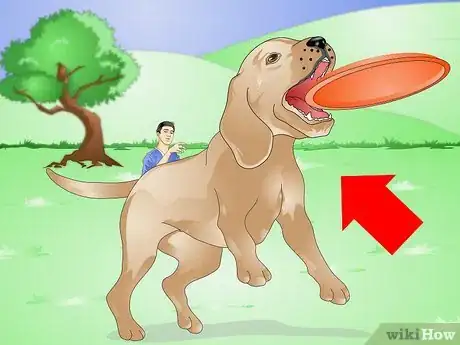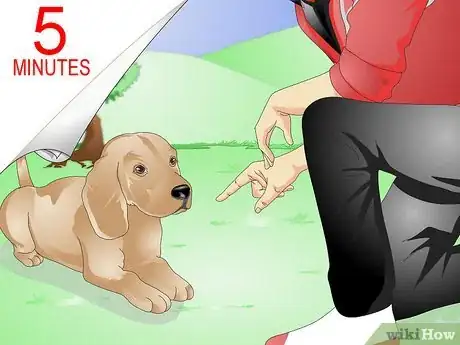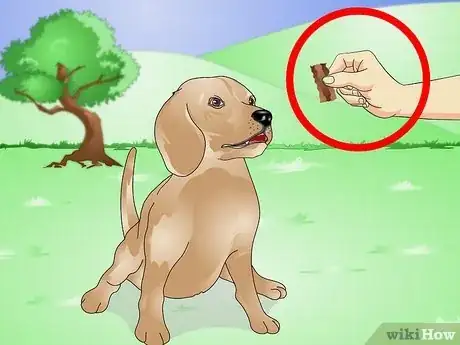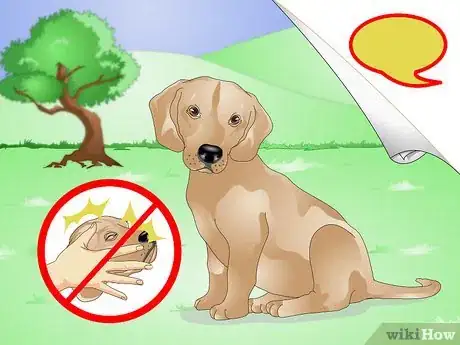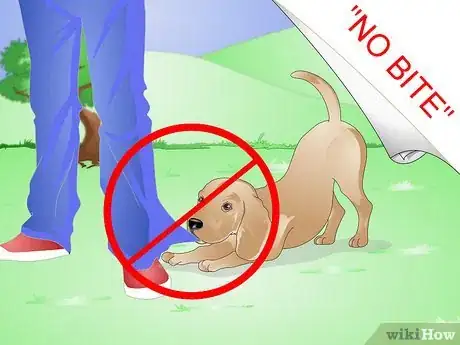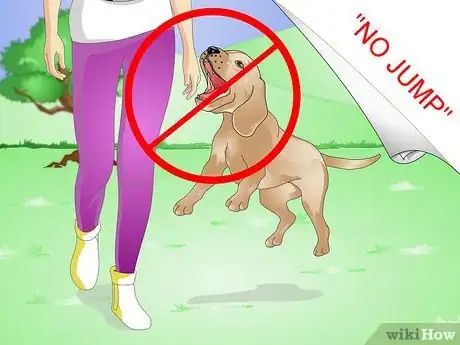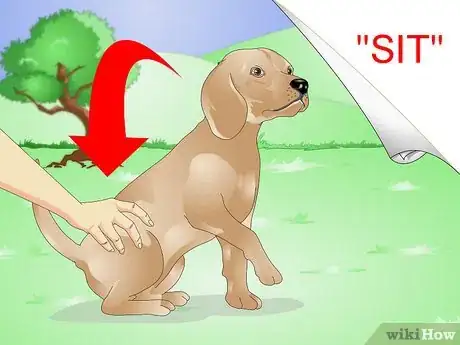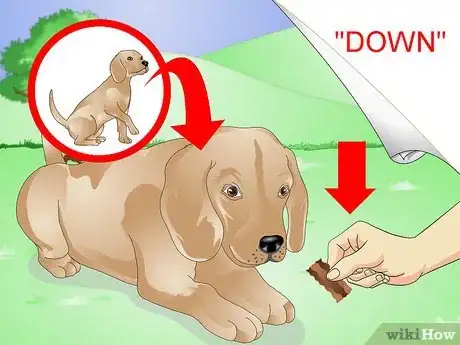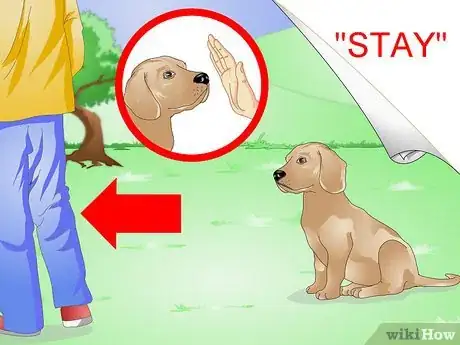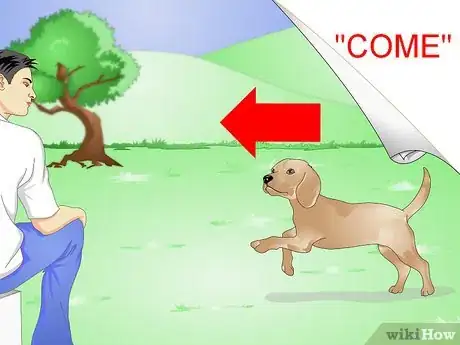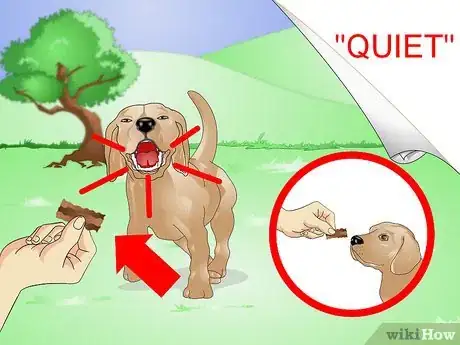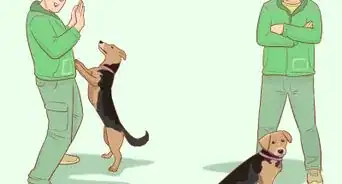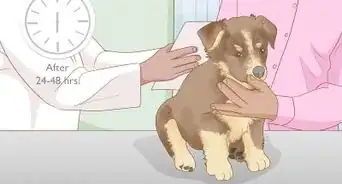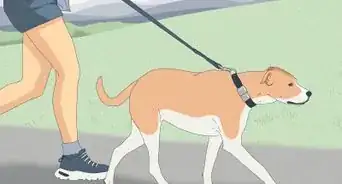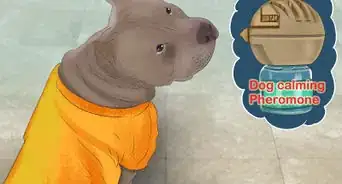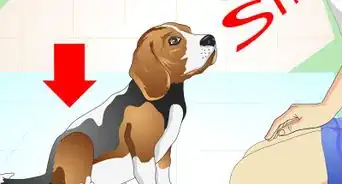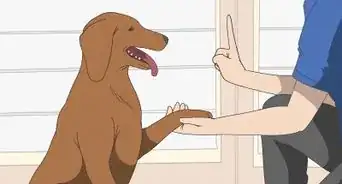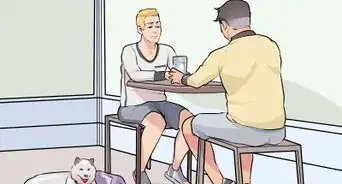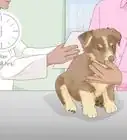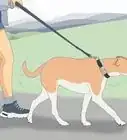This article was co-authored by Lauren Novack. Lauren Novack is a Certified Dog Behavior Consultant at Behavior Vets NYC where she helps fearful, anxious, and aggressive pets and their owners. She has completed coursework for her MS in Applied Behavior Analysis at Hunter College. Lauren’s research explores the intersection between training practices and animal welfare. She currently serves on the Editorial Advisory Board for Daily Paws and has appeared on Fox & Friends, Rachel Ray, and various news outlets with her dog Grayson.
wikiHow marks an article as reader-approved once it receives enough positive feedback. In this case, several readers have written to tell us that this article was helpful to them, earning it our reader-approved status.
This article has been viewed 54,591 times.
Hyper dogs are similar to any other dog. They thrive on positive attention from their humans and aim to please. In order to train hyper dogs you have to harness all their crazy energy into acceptable outlets. A well-trained hyper dog becomes a happy dog as it will know its position in its human family. By taking time each day to provide consistent, positive training to your hyper dog you can help it learn to calm itself and to become a great family pet along with a fantastic canine citizen.[1]
Steps
Harnessing Your Dog's Energy
-
1Exercise your dog before training. There is nothing to be gained by trying to train your hyper dog without first giving it a chance to burn off some energy. The best time to try a training session is after he or she has exercised vigorously. Try running your dog around the yard, playing a game of fetch or giving your dog a brisk walk in order to burn off the nervous, unproductive energy that we call hyperactivity.[2]
- It's most likely that your dog won’t be able to focus until it is physically pooped out.
-
2Give your dog short training sessions. After your dog has expended some energy, then do a short training session. Start with training sessions that are less than 5 minutes and then expand to 10 minutes as the dog is able to focus on you.Advertisement
-
3Use reward-based training.[3] This will work the best with a hyper dog. A positive reinforcement in the form of a small piece of a tasty treat or lavish praise is given immediately when the dog obeys the command.
- If you do not reward immediately the dog will quickly lose interest in working with you and won’t be able to understand what you expect.
- It is best to train the dog in an area with few distractions: a fenced in back yard with no other animals or humans or a quiet room in the house.
- Small, tasty treats of slivers of cheese or tiny cubes of cooked chicken should be kept handy at all times when training your hyper dog. A plastic baggie can be easily stashed in a pocket. Some people even wear fanny packs worn with the pouch in front to keep the treats in.
- Once the dog consistently obeys your commands start giving the treats intermittently along with tons of praise until you phase the treats out. At this point the dog is obeying you because it wants to please you. Remind it that you are pleased with it with occasional praise to reinforce training.
-
4Use short commands. Short one or two command words need to be used. Any longer will only confuse the dog and make you frustrated due to its lack of understanding. Give the command in a friendly voice and always praise your dog for any attempt in the right direction, no matter how small.
- Absolutely never hit or yell at your dog or you will lose its respect and make it afraid of you.
Teaching Essential Commands
-
1Teach no or stop. The first lesson to teach your hyper dog is the meaning of 'no' or 'stop'. You can use either one but use one consistently.
- You need to always be firm and consistent when using this command.
- Once you have said ‘no’ or ‘stop’ immediately move your dog away from whatever it is doing and once again say ‘no’ or 'stop'. Keep repeating until your dog stops and obeys you consistently.
-
2Teach your dog not to bite. You will need to teach your dog not to bite and chew during play if it has this habit. To begin with, help the dog avoid the temptation. Have plenty of toys available for your dog to chew on instead of chewing on people or things they shouldn't be chewing.
- If the dog does nip at you tap his nose lightly with your free hand and say “No bite.” As you pull your hand from the dog’s mouth, be sure to put a toy in its mouth and encourage it to bite the toy instead.
- Use a muzzle to positively condition the pup to not bite.[4]
- If at all times if you do not feel safe consult a veterinary behaviorist (your veterinarian can guide you) for advice.
- Chewing is a natural behavior but a destructive habit. Diversion works well in these cases. If you find your puppy chewing on an unacceptable object, take the item away, put it out reach and give the puppy a toy to chew on. As you take the item away, say “no chew” and give them a toy to chew on. The dog will eventually understand what it can and cannot chew.[5]
-
3Teach your dog not to jump up on people. Jumping on people can be a problem with hyper dogs. They generally do so to get your attention. Many times they also jump up during play, which can knock over and potentially injure people especially children, the disabled, and the elderly.
- If your hyper dog is a jumper, keep a leash on it to be able to correct it as it starts to jump and then give it the command to sit. Reward the dog when it promptly responds with a tasty treat. It will soon learn that jumping is not an appropriate behavior to display around people.[6]
-
4Teach your dog to sit. Dogs that sit promptly make feeding, grooming and, relaxing a joy. It is a simple command that most dogs learn easily. Have your dog stand in front of you and place a treat in your hand, letting your dog see it in your palm. Firmly say 'sit' in a friendly voice, while pushing the dog’s rear end down until it sits. Give the treat immediately along with praise.
- Repeat this process by stepping away from your dog, turn to face it, and telling it to sit. Continue to push the dog's rear down and praise it as you did before until it sits on its own.
- Work on the sit command for a few days until it is sitting promptly and consistently without the treat reward.
-
5Teach the dog to lay down. Once your hyper dog has learned to sit you can teach it the ‘down’ command. Have your dog sit while putting a treat in your hand. Making sure the dog knows you have the treat in your hand, put your hand near the dog's nose. While moving your hand to the floor say ‘down’ or ‘lay down.’ The dog should follow your hand to the floor by starting to lay down.
- As soon as the dog lays down, even if it’s a partial attempt, give the treat and praise.
- Practice this command until the dog is going down consistently. Practice this new command for up to a week until the dog has thoroughly learned ‘down.’
-
6Teach your dog to stay. Teaching a dog to stay will help you control your hyper dog even further. Tell your dog to 'sit', praise it when it obeys, and put your hand in front of the dog's face, wide open like a stop sign. Firmly say 'stay,' then back away slowly.
- Most likely the dog will run up it to you but command it to sit again. Then put your hand in front of the dog once again, say 'stay,' and back away while repeating stay.
- If the dog runs up to you, you will have to repeat it again.
- Once the dog stays don't let it come to you. Instead you go to the dog, praise it, and give it a treat. Repeat this process while going farther away from her than you did the previous time until your dog consistently obeys this command.
-
7Teach your dog to come. A very important command for your hyper dog to learn is ‘come.” A dog with a solid response to the ‘come’ command can be quickly recalled to your side if it is ever going towards danger or is acting hyper when it shouldn’t.[7]
- Start teaching this command when your dog is away from you, perhaps playing or sniffing around the yard or house. Crouch down, slap your thighs and say ‘come’ in a friendly voice. Your dog will think you are playing and will run to you eager to play with you. Reward it with a little treat and lots of praise.
- Work on this command at for a few weeks at different times when your dog is distracted, yet receptive to training. If it is off in the distance, slap your thighs and say 'come!' in a happy voice. Once it comes to you, praise it and repeat the word 'come!' a few times.
- At this point throw a treat and or a toy a short distance from you, and tell your dog to 'come' after it chases it down. Be persistent. If necessary, always have a treat or a toy that the dog loves more than the one you threw. Wave it to the dog once it looks up and say 'come!' Once it returns to you, praise and repeat.
- Work on this important command once a day until your dog has it down solidly.
-
8Teach your dog to quiet down. Although you might want your dog to bark when people come to your home, it should also learn the ‘quiet’ command to quit barking when you want it to. Keep treats handy so that when the dog starts to bark you can take one out and say ‘quiet.’
- Draw the dog's attention to the treat and when it stops barking immediately give the reward. This will help the dog associate the word “quiet” with stopping barking. It may take a while but eventually it’ll understand that you expect it to hush when you say quiet. Consistency and patience are key to making this work for both of you.
Expert Q&A
Did you know you can get expert answers for this article?
Unlock expert answers by supporting wikiHow
-
QuestionWhat are some good exercises to help calm my dog down before training them?
 Ty BrownTy Brown is a Dog Behaviorist and Trainer and the Owner of Ty the Dog Guy, a business that provides dog training through digital resources (podcasts, web series, and online courses) along with in-person dog training. Ty has over 17 years of experience in dog training and specializes in both mitigating unruly pet behavior and service dog training. Ty has been awarded the "Best of State Award" for dog training in Utah ten times and his work has been featured in ABC, NBC, CBS, Spike TV, and Entrepreneur Magazine.
Ty BrownTy Brown is a Dog Behaviorist and Trainer and the Owner of Ty the Dog Guy, a business that provides dog training through digital resources (podcasts, web series, and online courses) along with in-person dog training. Ty has over 17 years of experience in dog training and specializes in both mitigating unruly pet behavior and service dog training. Ty has been awarded the "Best of State Award" for dog training in Utah ten times and his work has been featured in ABC, NBC, CBS, Spike TV, and Entrepreneur Magazine.
Dog Trainer
-
QuestionHow do you teach a dog tricks?
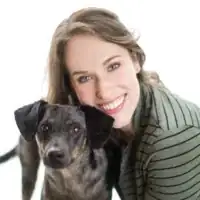 Lauren NovackLauren Novack is a Certified Dog Behavior Consultant at Behavior Vets NYC where she helps fearful, anxious, and aggressive pets and their owners. She has completed coursework for her MS in Applied Behavior Analysis at Hunter College. Lauren’s research explores the intersection between training practices and animal welfare. She currently serves on the Editorial Advisory Board for Daily Paws and has appeared on Fox & Friends, Rachel Ray, and various news outlets with her dog Grayson.
Lauren NovackLauren Novack is a Certified Dog Behavior Consultant at Behavior Vets NYC where she helps fearful, anxious, and aggressive pets and their owners. She has completed coursework for her MS in Applied Behavior Analysis at Hunter College. Lauren’s research explores the intersection between training practices and animal welfare. She currently serves on the Editorial Advisory Board for Daily Paws and has appeared on Fox & Friends, Rachel Ray, and various news outlets with her dog Grayson.
Certified Dog Behavior Consultant
-
QuestionDoes a muzzle help with nipping?
 Lauren NovackLauren Novack is a Certified Dog Behavior Consultant at Behavior Vets NYC where she helps fearful, anxious, and aggressive pets and their owners. She has completed coursework for her MS in Applied Behavior Analysis at Hunter College. Lauren’s research explores the intersection between training practices and animal welfare. She currently serves on the Editorial Advisory Board for Daily Paws and has appeared on Fox & Friends, Rachel Ray, and various news outlets with her dog Grayson.
Lauren NovackLauren Novack is a Certified Dog Behavior Consultant at Behavior Vets NYC where she helps fearful, anxious, and aggressive pets and their owners. She has completed coursework for her MS in Applied Behavior Analysis at Hunter College. Lauren’s research explores the intersection between training practices and animal welfare. She currently serves on the Editorial Advisory Board for Daily Paws and has appeared on Fox & Friends, Rachel Ray, and various news outlets with her dog Grayson.
Certified Dog Behavior Consultant When I hear the word ‘nipping’ I think of puppies not understanding boundaries yet. That’s different from biting which is usually a behavior meant to increase distance between the dog and the person being bitten. Muzzles can be positively conditioned so that pups like wearing them. All pups should be conditioned to wear a muzzle. A muzzle isn’t used to correct behavior, but can be used as an extra layer of safety in case you make a training mistake. If your dog has a history of showing it’s teeth, growling, snapping, or biting, you need to seek the counsel of a veterinary behaviorist or certified behavior consultant.
When I hear the word ‘nipping’ I think of puppies not understanding boundaries yet. That’s different from biting which is usually a behavior meant to increase distance between the dog and the person being bitten. Muzzles can be positively conditioned so that pups like wearing them. All pups should be conditioned to wear a muzzle. A muzzle isn’t used to correct behavior, but can be used as an extra layer of safety in case you make a training mistake. If your dog has a history of showing it’s teeth, growling, snapping, or biting, you need to seek the counsel of a veterinary behaviorist or certified behavior consultant.
Warnings
- Never yell inappropriately at your dog. If you are training him and he doesn't fully understand, do NOT become impatient and scold him, he is only learning. Step away from him if you become frustrated and try again later.⧼thumbs_response⧽
- Never strike or hit your dog. Hitting a dog will make him fear, and eventually, resent you damaging the bond between you both. Walk away from the situation if you find yourself getting angry.⧼thumbs_response⧽
References
- ↑ Ty Brown. Dog Trainer. Expert Interview. 4 June 2020.
- ↑ Ty Brown. Dog Trainer. Expert Interview. 4 June 2020.
- ↑ Ty Brown. Dog Trainer. Expert Interview. 4 June 2020.
- ↑ Lauren Baker, DVM, PhD. Veterinarian. Expert Interview. 29 May 2019.
- ↑ Canine and Feline Behavior for Veterinary Technicians and Nurses. Edited by Julie Shaw and Debbie Martin. John Wiley & Sons, Inc. 2015
- ↑ Behavior Problems of the Dog and Cat 3: Behavior Problems of the Dog and Cat. G.M. Landsberg, W. L. Hunthausen and L. J. Ackerman. Elsevier. 2013
- ↑ Handbook of Applied Dog Behavior and Training, Procedures and Protocols. Volume 3. Steven R. Lindsay. Blackwell Publishing. 2005
- ↑ Ty Brown. Dog Trainer. Expert Interview. 4 June 2020.
About This Article
To train a hyper dog, start by running your dog around the yard or playing a game of fetch to burn off some energy before you begin a training session. Then, find a place without distractions, such as a fenced yard or a quiet room inside. When your dog follows a command, reward it with lots of verbal praise or its favorite treat to keep it motivated. Additionally, keep your training sessions to 5 minutes, and gradually work up to 10 minutes as your dog's focus improves. For advice from our Veterinary co-author on how to decide which commands to teach your dog first, read on!

